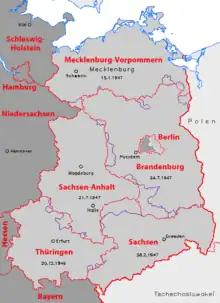The Ländereinführungsgesetz (English: State establishing act), adopted on 22 July 1990 by the Volkskammer recreated the Länder in the German Democratic Republic where they had been abolished in 1952. Since the new länder were formed by merging the kreise of East Germany, their borders differ from the ones of 1947. Originally, it was supposed to come into force on 14 October. Eventually, this date was changed to 3 October, the date of reunification, by the Einigungsvertrag (English: Unification treaty).[1]
The act also was supposed to regulate the relationship of the state and the federal level. As, however, it did not come into force before reunification, these parts of the act were immediately superseded by the corresponding articles of the Basic Law and never had any significance.
The full official title of the act is "Verfassungsgesetz zur Bildung von Ländern in der Deutschen Demokratischen Republik" (English: Constitutional law for the creation of states in the German Democratic Republic)
Composition of the newly created states

| State | Previous bezirke | Without the kreise | Plus the kreise |
|---|---|---|---|
| Mecklenburg-Vorpommern | Neubrandenburg, Rostock and Schwerin | Perleberg, Prenzlau and Templin | - |
| Brandenburg | Cottbus, Frankfurt/Oder and Potsdam | Hoyerswerda, Jessen and Weißwasser | Perleberg, Prenzlau and Templin |
| Sachsen-Anhalt | Halle and Magdeburg | Artern | Jessen |
| Sachsen | Dresden, Karl-Marx-Stadt/Chemnitz and Leipzig | Altenburg and Schmölln | Hoyerswerda and Weißwasser |
| Thüringen | Erfurt, Gera and Suhl | - | Altenburg, Artern and Schmölln |
See also
References
- ↑ "Die "KRR"-FAQ - Ländereinführungsgesetz" (in German). Archived from the original on 2010-06-11. Retrieved 2010-04-18.